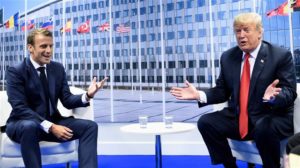 Annually, leaders of the twenty-nine North Atlantic Trade Organization (NATO) countries meet in one of the member nations to discuss critical issues and agenda items of the alliance, but summits are held for special changes. Although NATO is considered the most successful military alliance in modern history, this year the NATO summit met in Brussels under a cloud of pessimism because of the major disagreement among the member countries. President Donald Trump’s criticism of NATO allies and his trade wars with the European economies raised concern over the future of the transatlantic alliance At last week’s NATO meeting, President Trump urged members to contribute more in terms of finances, troops, and capabilities, just as the alliance is on the verge of making strategy changes. In his customary blunt straight talk, the President accused the allies of treating the US like “a piggy bank” by not paying their fair share of NATO’s costs. President Trump said that if Europe is afraid of Russian expansion, international terrorism, and an uncontrolled influx of migrants from other countries, they should share the burden more proportionately. Trump shocked NATO members further by saying they should not wait until 2024 to reach the goal of spending 2% of their GDP on their defense, but they should pay equitably now.
Annually, leaders of the twenty-nine North Atlantic Trade Organization (NATO) countries meet in one of the member nations to discuss critical issues and agenda items of the alliance, but summits are held for special changes. Although NATO is considered the most successful military alliance in modern history, this year the NATO summit met in Brussels under a cloud of pessimism because of the major disagreement among the member countries. President Donald Trump’s criticism of NATO allies and his trade wars with the European economies raised concern over the future of the transatlantic alliance At last week’s NATO meeting, President Trump urged members to contribute more in terms of finances, troops, and capabilities, just as the alliance is on the verge of making strategy changes. In his customary blunt straight talk, the President accused the allies of treating the US like “a piggy bank” by not paying their fair share of NATO’s costs. President Trump said that if Europe is afraid of Russian expansion, international terrorism, and an uncontrolled influx of migrants from other countries, they should share the burden more proportionately. Trump shocked NATO members further by saying they should not wait until 2024 to reach the goal of spending 2% of their GDP on their defense, but they should pay equitably now.
It is not clear whether the NATO allies will maintain their solidarity in the face of a significant threat to its relevance and sustainability; furthermore, the Brussels summit was unable to clarify its primary concerns, and the allies did little to brush over their disagreements causing the summit to be divided. The main problem with NATO is the threat perception among the principle partners in the alliance. For example, for Turkey and the Baltic states it is not clear whether NATO countries will be committed to their obligations to defend their allies in case of a threat.
For President Donald Trump, the main problem related to NATO is the financial cost of defending Europe. Currently only three NATO countries, other than the US, are meeting their 2% share. Trump argues that NATO is not sustainable unless European countries increase their share in defense of the alliance. President Trump sees these nations as free riders. He strongly criticized Germany with its massive trade surplus and high productivity. According to the World Bank’s measurement of the GDP of some NATO members, Germany is the world’s fourth richest nation; UK, the ninth; France, the tenth; and Italy, the eleventh. But they are very stingy in barely spending 1% of their GDP on their militaries, and instead have relied on allies to subsidize their defense against other countries. Meanwhile their at least nominal enemy, Russia, spends nearly 5.5 or 6% out of a GDP of nearly $1.5 trillion, less than half of Germany‘s nearly $3.8 trillion GDP, meaning that Moscow invests a much higher percentage on its military.
NATO’s intelligence, surveillance, and reconnaissance, air to air refueling, ballistics missile defense, and airborne electronic warfare are all paid for by the American taxpayers. It is a very legitimate objection from the President of the United States, so that he is rightly asking questions about why rich countries like Germany, which enjoys a $65 billion annual trade surplus with the U.S and the nearly $4 trillion GDP, cannot afford to pay more so that American taxpayers can spend less to defend them Solutions to these problems need to be sorted out to strengthen cooperation among the members and to invest further in the security infrastructures of the alliance.
In a divisive move, Germany has contracted with Russia to build the Nord Stream II pipeline for pumping 55 billion square meters of natural gas into Germany. In this deal with Russia the pipeline would bypass the Ukraine and leave other Eastern European countries more dependent on Moscow’s energy and thus more vulnerable. Having secured between 50 to 75% of its natural gas from Russia in 2017, Germany is playing it smart by objecting to Trump’s idea of increased defense spending and by cozying up to Russia. German Foreign Minister said in an interview, “We make free, sovereign decisions about our budget, our energy supplies, and our trade relationships on the basis of facts.” That position is based on national, not transnational interests thus showing signs of unraveling commitments.
Furthermore, among NATO members the US, Germany, the UK, Turkey, and France no longer have similar lists of threat perception. The spread of communism and nuclear proliferation are no longer the shared threats that caused the establishment of NATO. Trump’s administration does not consider Russia as its archenemy or rival; even more to the point, Turkey has started to see Russia as one of its key partners with regard to the war in Syria, trade, tourism, and even its purchase of missiles from the former Soviet Union. Germany has a long standing strategic energy cooperation with Russia. But at the same time, the Baltic states are very skeptical about Russian military activity in the Baltic Sea and in the regions. Georgia and the Ukraine remain vigilant about Putin’s intent to encroach on their sovereignty.
After World War II American leadership in transnational institutions, like the United Nations, the World Trade Organization, and NATO, created ruled-based order, so that interstate relations could be based on international cooperation. This cooperation was guided by shared principals, thus broadening the parochial interests of sovereign nations. Seemingly, giving national sovereignty to transnational leaders would create a more peaceful and orderly world, but in reality real peace and prosperity resulted not from the rule-based order, but from American military might stopping the Soviets and Communism. Today, if Russia becomes a real threat to NATO, then the alliance will need more forces on the ground to counterbalance Russian influence over the Baltic, Poland, and Eastern Europe, but the US is not willing to invest more in European security.
NATO members’ perspective concerning Russia, which used to be seen as a shared threat in the past, is just one example of the lack of consensus on threat perceptions. Views of the member countries concerning terrorist threats, ethnic cleansing, and cyber security have widened even more. The US does not see Russia as a major challenge to its global supremacy. Russia may eventual threaten the European Union’s power, but the major challenge for the United States is rising Chinese power. The fast rise of China in its economy and trade seem to be drivers of growth in the world economy. This growth does not insure security in the region. The next initial zone of confrontation will be the South China Sea. In the meantime, China is eyeing military bases in Pakistan, even if its economy growth is peaceful. The Trump administration feels that if they cannot do anything to stop China now, it will be very hard later to stop the giant later, and Europe will be too weak to help the US against China. Global trade wars are the best strategy to confront China.
President Trump’s disagreement with NATO shows the growing weakness of the international order. At this 28th summit since NATO’s inception in 1949, the question of whether the Heads of State were able to evaluate and provide strategic direction for the NATO allies remains unanswered. Generally, the summits are held to launch new initiatives or policies or to welcome new members, but President Trump’s criticism of the inequity of defense spending and of the transnational alliance’s relevance superseded such issues as terrorism or cybersecurity. Yet, NATO Secretary General Jens Stoltenberg, who chaired the summit, wrote that same week in the Financial Times that defending against cyber attacks matters as much as defending air, land, and sea spaces. Whether a cyber attack would trigger Article 5, Stoltenberg could not say, but he declared, “NATO is taking necessary steps to keep our nations and people safe,” a statement perhaps as rose-colored as President Trump’s assessment that the summit was “really great.”
Dr. Aland Mizell is President of the MCI and a regular contributor to Mindanao Times. You may email the author at:aland_mizell2@hotmail.com

